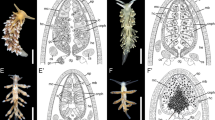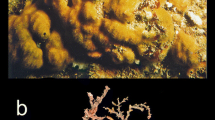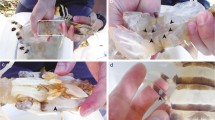Abstract
Three entosymbiotic graffillid rhabdocoels (Paravortex scrobiculariae, P. cardii and Graffilla buccinicola) from marine bivalve and gastropod molluscs show several physiological adaptations to their life-style which are intimately related to the nutritional physiology and ecology of their respective hosts.
All three species feed on their hosts' partially digested food plus the cellular debris released at the end of the hosts' own digestive cycle. G. buccinicola supplements this diet by actively removing intact cells from the host's digestive epithelium. Host enzymes, ingested with the food, are utilized for digestion within the flatworms' gut; there is concomitant reduction in the types and amounts of endogenous enzymes and the gastrodermal gland cells characteristically found in free-living species are absent.
Food reserves in the three species consist mainly of glycogen, following the pattern seen in other entosymbiotic flatworms (Turbellaria, Digenea, Cestoda); in P. scrobiculariae this primary adaptation, believed to be linked in all entosymbiotes to the ready availability of food and to high fecundity, probably has a secondary function, in relation to anaerobic respiration, of the type found in cestodes.
Other adaptive features, closely correlated with host ecology, are the occurrence of a physiologically active haemoglobin in the brain and pharynx of P. scrobiculariae and, in this species and P. cardii, the differential occurrence and distribution of dehydrogenase systems concerned with aerobic respiration (Krebs cycle), the pentose phosphate shunt and anaerobic respiration (glycolysis).
P. scrobiculariae and P. cardii are viviparous and the normal provision of yolk for embryonic nutrition is supplemented by direct passage of materials to the later larvae from the parental gut, thus facilitating extended development of the larva until its birth as an immature miniature adult.
Similar content being viewed by others
References
Atkinson, H. J., 1975. The functional significance of the haemoglobin in a marine nematode Enoplus brevis (Bastian). J. Exp. Biol. 62: 1–9.
Ball, S. J., 1916. Development of Paravortex gemellipara. J. Morphol. 27: 453–557.
Brand, T. von, 1946. Anaerobiosis in Invertebrates. Biodynamica, Normandy, Missouri. 328 pp.
Brand, T. von, 1973. Biochemistry of Parasites. 2nd. edn. New York: Academic Press, 499 pp.
Calow, P. & Jennings, J. B., 1974. Calorific values in the phylum Platyhelminthes: the relationship between potential energy, mode of life and the evolution of entoparasitism. Biol. Bull. 147: 81–94.
Crompton, D. W. T. & Smith, M. H., 1963. Haemoglobin in a flatworm. Nature, London 197: 1118–1119.
Gibson, R. & Jennings, J. B., 1969. Observations on the diet, feeding mechanism, digestion and food reserves of the entocommensal rhynchocoelan Malacobdella grossa O. F. Müller. J. Mar. Biol. Assoc. U.K. 49: 17–32.
Hyman, L. H., 1951. The Invertebrates: Platyhelminthes and Rhynchocoela. The acoelomate Bilateria II. New York: McGraw-Hill, 550 pp.
Jennings, J. B., 1971. Parasitism and commensalism in the Turbellaria. In: Ed. Dawes, B., Advances in Parasitology, 9, New York: Academic Press, pp. 1–32.
Jennings, J. B., 1974a. Symbioses in the Turbellaria and their implications in studies on the evolution of entoparasitism. In: Ed. Vernberg, W. B., Symbiosis in the Sea, Univ. South Carolina Press, Columbia, South Carolina, pp. 127–160.
Jennings, J. B., 1974b. Digestive physiology of the Turbellaria. In: Riser, N. W. & Morse, M. P. (eds.), Biology of the Turbellaria, pages 173–197. McGraw-Hill Book Co., New York.
Jennings, J. B., 1977. Patterns of nutritional physiology in free-living and symbiotic Turbellaria and their implications for the evolution of entoparasitism in the phylum Platyhelminthes. In: Karling, T. G. & Meinander, M. (eds.), The Alex Luther Centennial Symposium on Turbellaria. Acta Zool. fenn. 154: 63–79.
Jennings, J. B., 1980. Nutrition in symbiotic Turbellaria. In: Eds., Smith, D. C. & Tiffon, Y., Nutrition in the Lower Metazoa, Oxford: Pergamon Press, pp. 45–56.
Jennings, J. B. & Calow, P., 1975. The relationship between high fecundity and the evolution of entoparasitism. Oecologia 21: 109–115.
Jennings, J. B. & LeFlore, W. B., 1979. Occurrence and possible adaptive significance of some histochemically demonstrable dehydrogenases in two entosymbiotic rhabdocoels (Platyhelminthes: Turbellaria). Comp. Biochem. Physiol. 62B: 301–304.
Jennings, J. B. & Phillips, J. I., 1978. Feeding and digestion in three entosymbiotic graffillid rhabdocoels from bivalve and gastropod molluscs. Biol. Bull. 155: 542–562.
Mettrick, D. F. & Jennings, J. B., 1969. Nutrition and chemical composition of the rhabdocoel turbellarian Syndesmis franciscana, with notes on the taxonomy of S. antillarum. Can. J. Zool. 26: 2669–2679.
Morton, J. E., 1967. Molluscs. 4th edn. London: Hutchinson and Co., 244 pp.
Owen, G., 1966. Digestion. In: Eds., Yonge, C. M. & Wilbur, K. M., Physiology of Mollusca, vol. 2, New York: Academic Press, pp. 53–96.
Owen, G., 1972. Lysosomes, peroxisomes and bivalves. Sci. Prog. 60: 299–318.
Owen, G., 1974. Feeding and digestion in the Bivalvia. In: Ed., Lowenstein, O., Advances in Comparative Physiology and Biochemistry, 5, New York: Academic Press, pp. 1–35.
Pearse, A. G. E., 1972. Histochemistry: theoretical and applied. 3rd edn. Edinburgh: Churchill Livingstone.
Phillips, J. I., 1978. The occurrence and distribution of haemoglobin in the entosymbiotic rhabdocoel Paravortex scrobiculariae (Graff) (Platyhelminthes: Turbellaria). Comp. Biochem. Physiol. 61A: 679–683.
Prosser, C. L., 1973. Respiratory functions of blood. In: Ed., Prosser, C. L., Comparative Animal Physiology, pages 317–361. New York: Academic Press.
Purchon, R. D., 1977. The Biology of the Mollusca, 2nd edn. Oxford: Pergamon Press, 560 pp.
Read, C. P., 1968. Intermediary metabolism of flatworms. In: Eds. Florkin, M. & Scheer, B. T., Chemical Zoology 2, New York: Academic Press, pp. 327–357.
Wittenberg, J. B., 1970. Myoglobin-facilitated oxygen diffusion: role of myoglobin in oxygen entry into muscle. Physiol. Rev. 50: 559–636.
Young, J. O. & Harris, J. H., 1973. Another instance of haemoglobin in a flatworm Phaenocora typhlops (Vejdovsky 1880). Freshwater Biol. 3: 85–88.
Author information
Authors and Affiliations
Rights and permissions
About this article
Cite this article
Jennings, J.B. Physiological adaptations to entosymbiosis in three species of graffillid rhabdocoels. Hydrobiologia 84, 147–153 (1981). https://doi.org/10.1007/BF00026173
Issue Date:
DOI: https://doi.org/10.1007/BF00026173




